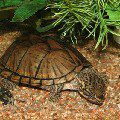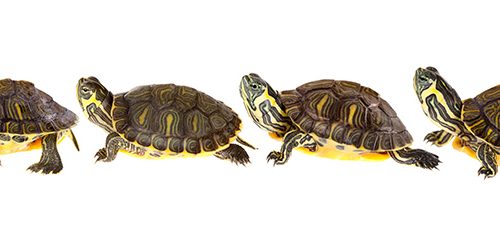
Common musk turtle
This species of turtle lives in the east and southeast of the United States and in the southeast of Canada. Prefers most of all freshwater reservoirs and muddy bottom. Basically, the turtle leads an aquatic lifestyle (it can even become overgrown with algae). Turtle activity peaks at dusk and at night. Most of the time, the turtle wanders along the bottom of the reservoir in search of food.
The length of the carapace is on average 13,5 cm, it is oval in shape, in young individuals it has three longitudinal ridges. Males differ from females in having a short plastron, a longer tail, and spiny scales that are located on the inner sides of the hind legs.
It feeds mainly on mollusks, aquatic insects, small fish and aquatic vegetation. This turtle also eats carrion, which makes it a good orderly of the reservoir.
Mating takes place underwater. The turtle lays in the period from April to July, in shallow holes, which the turtle rarely digs on its own, but most often does it in depressions in the soil, or leaves eggs on the surface. The incubation period lasts 60-107 days at a temperature of 25 to 29 degrees.
When caught, the common musk turtle can behave extremely belligerently, bite painfully and actively break out. Also, as a defense, it can secrete a strong-smelling secret from the musk glands located on the side and behind the shell under the shell. They can live over 20 years in captivity.
Other names
Sternotherus odoratus
Types
Sternotherus carinatus
Inhabitation
The common musk turtle lives in various freshwater reservoirs with a silty bottom, in the east and southeast of the United States, and also penetrates into the southeast of Canada. Leads an exclusively aquatic lifestyle, often because of this lifestyle they can become overgrown with algae. Most often, the common musk turtle wanders in search of food along the bottom of the reservoir, although at the same time it swims quite tolerably. This turtle comes to the surface extremely rarely, mainly in order to lay eggs or during rain. The common musk turtle becomes most active at dusk and at night.
Sometimes a turtle on the surface exposes the dorsal part of the shell to the sun for heating, sometimes they can even climb branches that bend over the water, and at the same time, they can do this even at a height of up to two meters. When danger arises, turtles fall into the water.
The common musk turtle hibernates, buried deep in the silt at the bottom of the reservoir. Moreover, in cases where for some reason the reservoir dries up, then the turtle can be accidentally found at those moments when it decides to look for a more acceptable shelter, even in the snow.
Description
Members of the musk turtle genus got their name because of the very strong musky smell. The locals even call them “stinkers” or “Stinky Jim”.
It swims remarkably, but spends most of its time in search of food, moving along the bottom of the reservoir.
This species of turtles has an oval carapace, in young individuals it has three longitudinal ridges. The length of the carapace reaches 13 cm. The plastron is small, with a single inconspicuous ligament and 5 scutes. The plastron itself is oval in shape, its anterior lobe is movably connected to the main part. However, at the same time, the scope of movement for this part is extremely limited, so the turtle is not able to close the front hole with it, as closed turtles do. The main background of the head and neck of the common musk turtle is dirty brown; against its background, longitudinal light stripes are clearly distinguished.
Male musk turtles differ from females in a longer tail with a blunt crest, spiny scales that are located on the inside of the hind legs and a short plastron. As for the scales, they help the female to hold the female during mating. Previously, these scales were called “chirp organs” and it is still quite common to find a similar explanation of their function in popular literature. And indeed, when these scales rub against each other when bending the limbs, they produce sounds similar to the chirping or singing of a cricket. And thanks to its long neck, the common musk turtle can reach its hind legs with its own jaw.
On the throat, lower jaw and neck, representatives of this species of turtles have small outgrowths that resemble warts and their location distinguishes the common musk turtle from other species of this genus.
Food
This turtle feeds on mollusks, small fish, aquatic insects and aquatic vegetation. At the same time, it is considered an orderly of reservoirs, as it willingly eats various carrion.
In order to avoid severe contamination of water with food residues in terrarium conditions, tweezers or special needles for stringing food can be used. If tempting pieces of food hang temptingly in front of the nose of a hungry turtle, then it will quickly get used to this way of feeding and quickly get used to it. Young individuals quite successfully catch fish that live with them in the same aquaterrarium (for example, guppies or zebrafish).
Reproduction
Sexual maturity in the common musk turtle occurs at the age of about a year.
Mating takes place underwater. Laying is done from April to July. The female digs a small hole and lays from 2 to 7 eggs in it, which are covered with a fragile hard shell. Although more often the female does not place the eggs in a self-dug nest, but uses a recess in the soil, or even leaves the eggs on the surface.
The incubation period lasts from 60 to 107 days at a temperature of 25 to 29 degrees.
A fertilized female musk turtle can remain fertile for up to four years. Little turtles grow up fast enough.
Musk turtle species breeds well, so there is no threat of extinction of the species.
Content
 This type of turtle is almost a favorite representative of terrarium collections. It is omnivorous, tolerant of room temperature. In captivity, the common musk turtle can live up to 23 years.
This type of turtle is almost a favorite representative of terrarium collections. It is omnivorous, tolerant of room temperature. In captivity, the common musk turtle can live up to 23 years.
Some guidelines for keeping the common musk turtle speak of the need for a shallow pond, the height of the water in the aquaterrarium should be about 10-15 cm. However, as it turned out, this is not at all necessary. Researcher Gerhard Müller reports that he kept common musk turtles in an aquaterrarium, the water level in which was 50-60, and in pond conditions the water level increased to 85 cm. Difficulties arose only with those reptiles that came to the terrariumist from other collectors. These individuals have adapted to shallow water over the years. In such cases, some adaptation period was required.
The muddy bottom, which the turtle prefers in natural conditions, is quite difficult to reproduce at home. You can replace it with strong branches, a decorative pine tree root and a couple of stones. Decorations can be placed in such a way that they serve as a bridge from the water to the dry part of the terrarium.

You will need to put a good filter in the aquarium, or change the water every two days, while fresh water should be the same temperature as the suction. If there is no outlet pipe for changing the water, then the use of a suction hose will be required. It is also necessary to pay attention to the fact that litter and other dirt come out with the suction water. The temperature of fresh water for filling the reservoir should be the same as the temperature of the suction water. In this case, it would be more expedient to use settled water, since harmful chlorine has already evaporated from it. The fact is that the common musk turtle is very sloppy, therefore, without good filtration, the water area is quickly polluted. UV lamp is not required. The water temperature should be between 22 and 30 degrees and the air temperature should be between 25 and 30 degrees.
You need to feed the musk turtle in a variety of ways – in addition to ready-made food, you must have live food – aquatic snails, shrimp, slugs, newborn mice, worms, squid meat, bloodworms, fish, etc. Sometimes you will need to include plant foods in the diet, the common musk turtle prefers duckweed or salad.
During oviposition, the artificial shore should be separated from the water part of the aquaterrarium by placing a glass plate at an angle. If one is not available, then you can use a brick or make your own sand embankment. On the shore for laying eggs, you will need to make a cuvette with sand.
In the territories of Central Europe, terrariumists often take their turtles to outdoor ponds for the summer, where the turtle feels great.
Musk turtles can also be kept in small groups. This will require a spacious volume, and the exclusion of competition during meals.
In conditions of terrarium maintenance without wintering, males can “pay” attention to the female almost all year round. In this case, periods of courtship are interspersed with periods of rest. The peak of sexual activity falls on warm sunny weather in summer and spring, provided that it is kept outdoors. There is no special mating dance in the common musk turtle. Mating lasts from an hour to almost a day. At the same time, the male does not try to hold the female by the “nape” and copulation proceeds quite calmly.
Additionally
When caught, the common musk turtle behaves quite belligerently, bites painfully and breaks out very vigorously. Also, as a protection, from the musk glands located on the side and behind under the shell, it secretes a yellowish secret with an extremely unpleasant odor. Males are extremely aggressive and can actively bite. However, after the passage of time in captivity, the character changes, one becomes more peaceful and calm. Life expectancy in captivity averages 20-25 years.
One of the main features of this representative of the musk turtle genus is the ability to breathe underwater with the help of the tongue. Special tubercles on the turtle’s tongue allow oxygen to be absorbed directly from the water, which allows the turtle to stay underwater for long periods of time – up to several months. Observations by researchers have shown that young individuals of the common musk turtle always drag food under water, until this moment they simply cannot eat it. Their weak and small tongue is simply not designed to assist with swallowing. Subsequent studies have shown that the tongue of the common musk turtle does not perform the same functions as in other animals. Knowing that somewhere this turtle must have an organ that is adapted for underwater breathing, the researchers finally found it. Some species have special sinuses that help absorb oxygen from the water, while others have the ability to breathe through the skin. As a result, after a long period of time, researchers finally managed to find such an adaptation in the common musk turtle.
Sources of
http://ru.wikipedia.org
http://www.cherepahi.ru
http://www.rocka.ru
http://allforpets.com.ua
http://mypets.by





